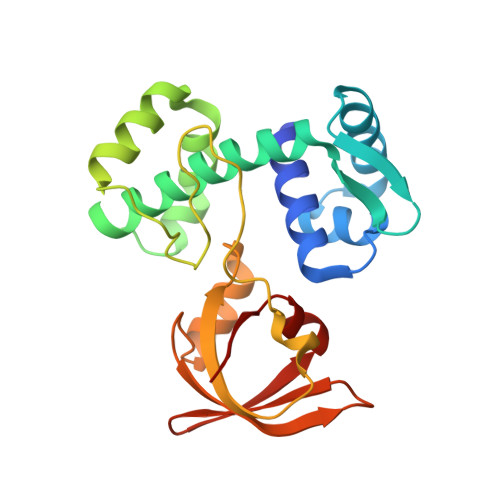Metal sensing and regulation of adaptive responses to manganese limitation by MtsR is critical for group A streptococcus virulence.
Do, H., Makthal, N., Chandrangsu, P., Olsen, R.J., Helmann, J.D., Musser, J.M., Kumaraswami, M.(2019) Nucleic Acids Res 47: 7476-7493
- PubMed: 31188450
- DOI: https://doi.org/10.1093/nar/gkz524
- Primary Citation of Related Structures:
6O5C - PubMed Abstract:
Pathogenic bacteria encounter host-imposed manganese (Mn) limitation during infection. Herein we report that in the human pathogen Streptococcus pyogenes, the adaptive response to Mn limitation is controlled by a DtxR family metalloregulator, MtsR. Genes upregulated by MtsR during Mn limitation include Mn (mtsABC) and Fe acquisition systems (sia operon), and a metal-independent DNA synthesis enzyme (nrdFEI.2). To elucidate the mechanism of metal sensing and gene regulation by MtsR, we determined the crystal structure of MtsR. MtsR employs two Mn-sensing sites to monitor metal availability, and metal occupancy at each site influences MtsR regulatory activity. The site 1 acts as the primary Mn sensing site, and loss of metal at site 1 causes robust upregulation of mtsABC. The vacant site 2 causes partial induction of mtsABC, indicating that site 2 functions as secondary Mn sensing site. Furthermore, we show that the C-terminal FeoA domains of adjacent dimers participate in the oligomerization of MtsR on DNA, and multimerization is critical for MtsR regulatory activity. Finally, the mtsR mutant strains defective in metal sensing and oligomerization are attenuated for virulence in a mouse model of invasive infection, indicating that Mn sensing and gene regulation by MtsR are critical processes during S. pyogenes infection.
Organizational Affiliation:
Center for Molecular and Translational Human Infectious Diseases Research, Houston Methodist Research Institute, and Department of Pathology and Genomic Medicine, Houston Methodist Hospital, Houston, TX 77030, USA.
















